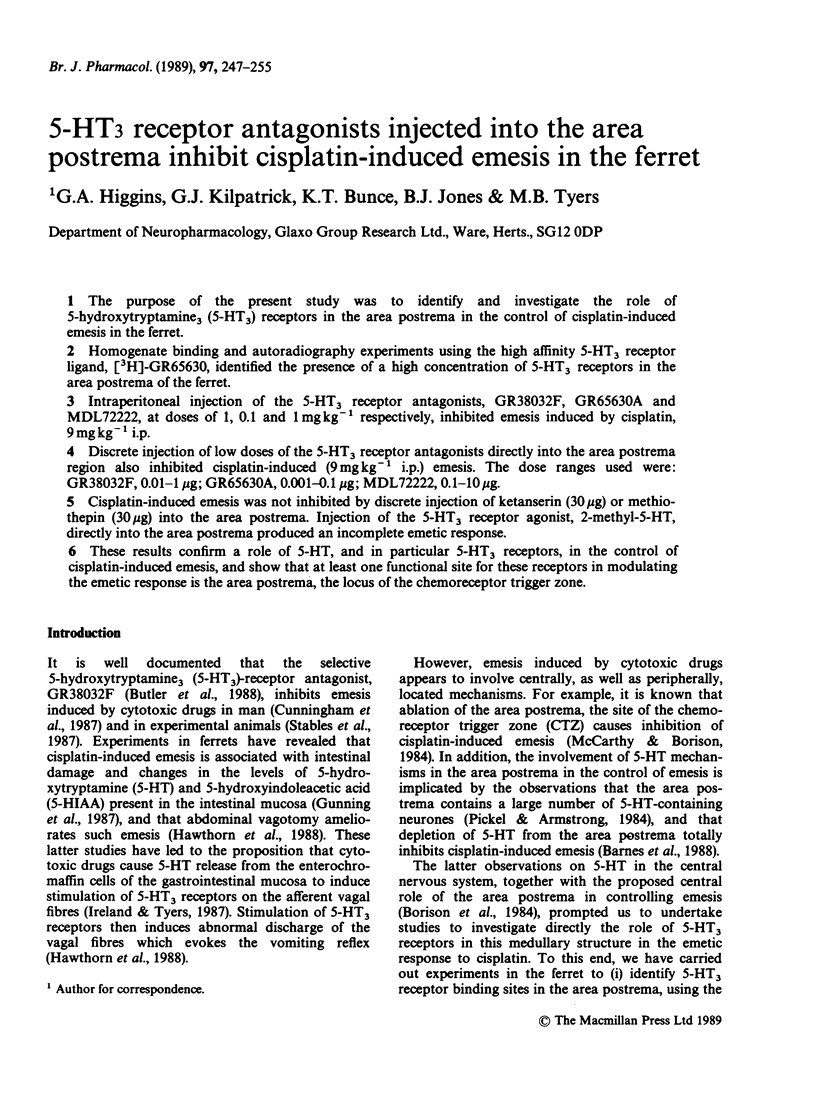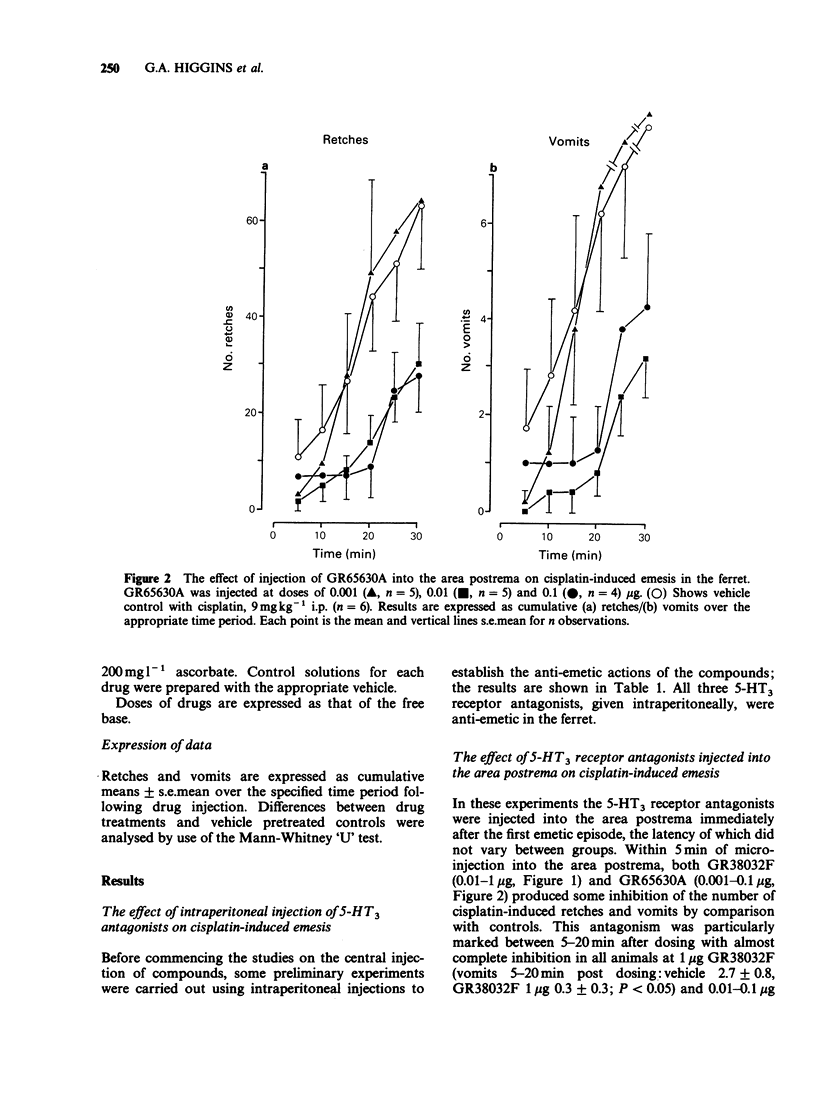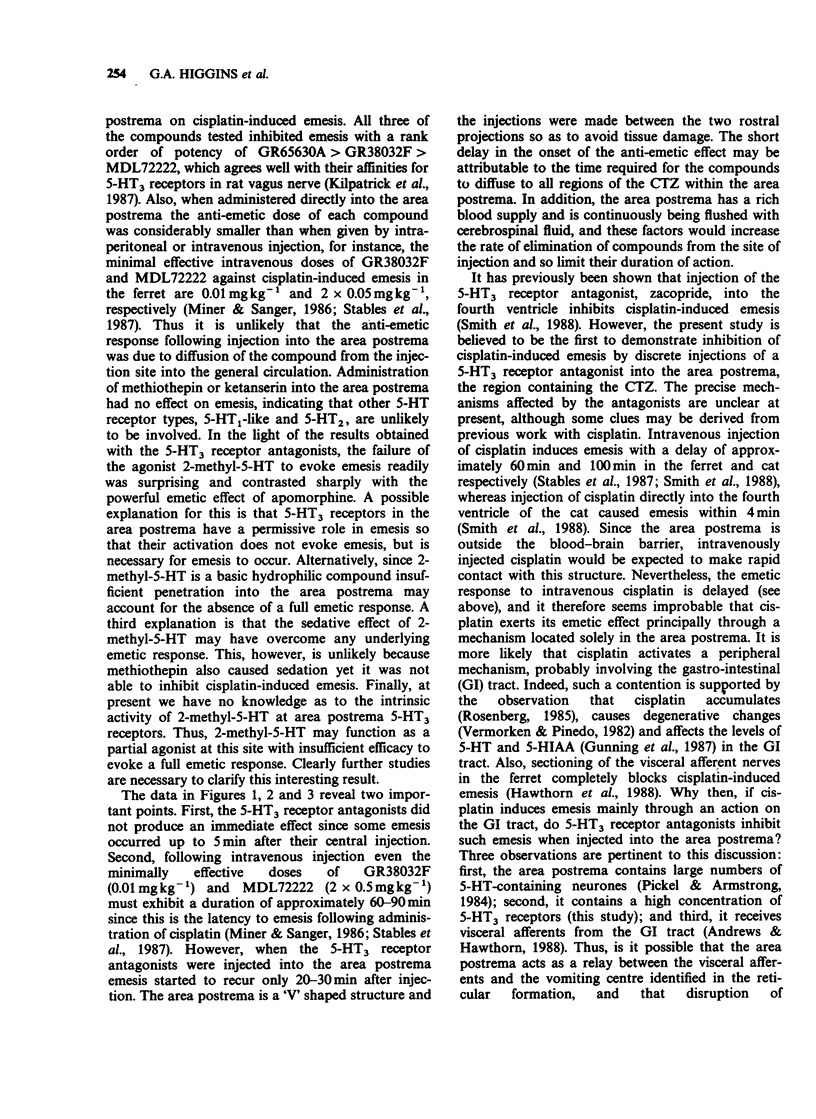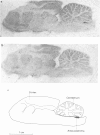Abstract
1. The purpose of the present study was to identify and investigate the role of 5-hydroxytryptamine3 (5-HT3) receptors in the area postrema in the control of cisplatin-induced emesis in the ferret. 2. Homogenate binding and autoradiography experiments using the high affinity 5-HT3 receptor ligand, [3H]-GR65630, identified the presence of a high concentration of 5-HT3 receptors in the area postrema of the ferret. 3. Intraperitoneal injection of the 5-HT3 receptor antagonists, GR38032F, GR65630A and MDL72222, at doses of 1, 0.1 and 1 mg kg-1 respectively, inhibited emesis induced by cisplatin, 9 mg kg-1 i.p. 4. Discrete injection of low doses of the 5-HT3 receptor antagonists directly into the area postrema region also inhibited cisplatin-induced (9 mg kg-1 i.p.) emesis. The dose ranges used were: GR38032F, 0.01-1 microgram; GR65630A, 0.001-0.1 microgram; MDL72222, 0.1-10 micrograms. 5. Cisplatin-induced emesis was not inhibited by discrete injection of ketanserin (30 micrograms) or methiothepin (30 micrograms) into the area postrema. Injection of the 5-HT3 receptor agonist, 2-methyl-5-HT, directly into the area postrema produced an incomplete emetic response. 6. These results confirm a role of 5-HT, and in particular 5-HT3 receptors, in the control of cisplatin-induced emesis, and show that at least one functional site for these receptors in modulating the emetic response is the area postrema, the locus of the chemoreceptor trigger zone.
Full text
PDF








Images in this article
Selected References
These references are in PubMed. This may not be the complete list of references from this article.
- Barnes J. M., Barnes N. M., Costall B., Naylor R. J., Tattersall F. D. Reserpine, para-chlorophenylalanine and fenfluramine antagonise cisplatin-induced emesis in the ferret. Neuropharmacology. 1988 Aug;27(8):783–790. doi: 10.1016/0028-3908(88)90092-5. [DOI] [PubMed] [Google Scholar]
- Borison H. L., Borison R., McCarthy L. E. Role of the area postrema in vomiting and related functions. Fed Proc. 1984 Dec;43(15):2955–2958. [PubMed] [Google Scholar]
- Bradford M. M. A rapid and sensitive method for the quantitation of microgram quantities of protein utilizing the principle of protein-dye binding. Anal Biochem. 1976 May 7;72:248–254. doi: 10.1006/abio.1976.9999. [DOI] [PubMed] [Google Scholar]
- Butler A., Hill J. M., Ireland S. J., Jordan C. C., Tyers M. B. Pharmacological properties of GR38032F, a novel antagonist at 5-HT3 receptors. Br J Pharmacol. 1988 Jun;94(2):397–412. doi: 10.1111/j.1476-5381.1988.tb11542.x. [DOI] [PMC free article] [PubMed] [Google Scholar]
- Cunningham D., Hawthorn J., Pople A., Gazet J. C., Ford H. T., Challoner T., Coombes R. C. Prevention of emesis in patients receiving cytotoxic drugs by GR38032F, a selective 5-HT3 receptor antagonist. Lancet. 1987 Jun 27;1(8548):1461–1463. doi: 10.1016/s0140-6736(87)92208-2. [DOI] [PubMed] [Google Scholar]
- Hawthorn J., Ostler K. J., Andrews P. L. The role of the abdominal visceral innervation and 5-hydroxytryptamine M-receptors in vomiting induced by the cytotoxic drugs cyclophosphamide and cis-platin in the ferret. Q J Exp Physiol. 1988 Jan;73(1):7–21. doi: 10.1113/expphysiol.1988.sp003124. [DOI] [PubMed] [Google Scholar]
- Ireland S. J., Tyers M. B. Pharmacological characterization of 5-hydroxytryptamine-induced depolarization of the rat isolated vagus nerve. Br J Pharmacol. 1987 Jan;90(1):229–238. doi: 10.1111/j.1476-5381.1987.tb16844.x. [DOI] [PMC free article] [PubMed] [Google Scholar]
- Kilpatrick G. J., Jones B. J., Tyers M. B. Identification and distribution of 5-HT3 receptors in rat brain using radioligand binding. Nature. 1987 Dec 24;330(6150):746–748. doi: 10.1038/330746a0. [DOI] [PubMed] [Google Scholar]
- McCarthy L. E., Borison H. L. Cisplatin-induced vomiting eliminated by ablation of the area postrema in cats. Cancer Treat Rep. 1984 Feb;68(2):401–404. [PubMed] [Google Scholar]
- Miner W. D., Sanger G. J. Inhibition of cisplatin-induced vomiting by selective 5-hydroxytryptamine M-receptor antagonism. Br J Pharmacol. 1986 Jul;88(3):497–499. doi: 10.1111/j.1476-5381.1986.tb10228.x. [DOI] [PMC free article] [PubMed] [Google Scholar]
- Pickel V. M., Armstrong D. M. Ultrastructural localization of monoamines and peptides in rat area postrema. Fed Proc. 1984 Dec;43(15):2949–2951. [PubMed] [Google Scholar]
- Rosenberg B. Fundamental studies with cisplatin. Cancer. 1985 May 15;55(10):2303–23l6. doi: 10.1002/1097-0142(19850515)55:10<2303::aid-cncr2820551002>3.0.co;2-l. [DOI] [PubMed] [Google Scholar]
- Smith W. L., Callaham E. M., Alphin R. S. The emetic activity of centrally administered cisplatin in cats and its antagonism by zacopride. J Pharm Pharmacol. 1988 Feb;40(2):142–143. doi: 10.1111/j.2042-7158.1988.tb05202.x. [DOI] [PubMed] [Google Scholar]
- Stables R., Andrews P. L., Bailey H. E., Costall B., Gunning S. J., Hawthorn J., Naylor R. J., Tyers M. B. Antiemetic properties of the 5HT3-receptor antagonist, GR38032F. Cancer Treat Rev. 1987 Dec;14(3-4):333–336. doi: 10.1016/0305-7372(87)90026-0. [DOI] [PubMed] [Google Scholar]
- Vermorken J. B., Pinedo H. M. Gastrointestinal toxicity of cis-diamminedichloroplatinum (II). Neth J Med. 1982;25(8):275–279. [PubMed] [Google Scholar]



